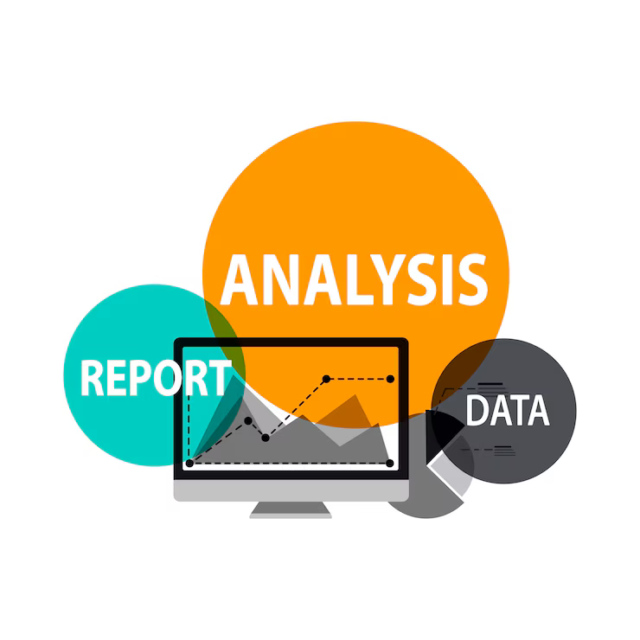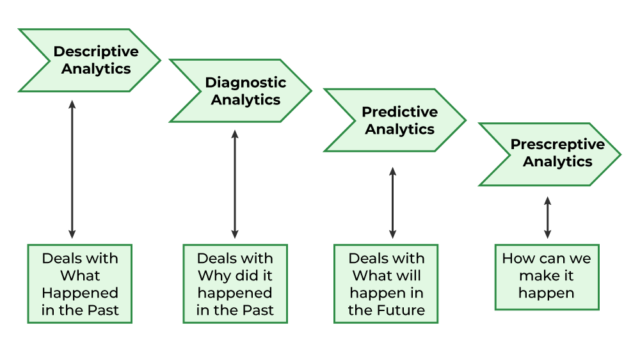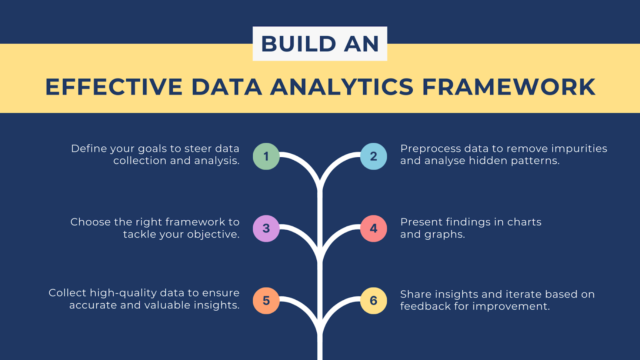Introduction
Modern organisations generate data at a vast scale. But it is what you do with it that drives the real impact. That is why a well-structured data and analytics framework has become a necessity.
According to McKinsey Global Institute, there is a 23% higher chance of acquiring customers, 6 times for retaining them, and 19 times for generating profitability for data-driven companies.
Still, many companies struggle to get the real value from their data. It is simply because they lack a connected system to manage, analyse, and act on it.
The powerful data analytics frameworks give your company a guideline to turn raw data into actionable insight. It brings tools, people, processes, and technologies together in a unified structure that supports better and faster outcomes.
In this guide, we will understand:
- What a data and analytics framework actually is
- The key components and models that work with it
- Different industries using the framework
- Step-by-step strategies to build your own framework that scales.
What is a Data and Analytics Framework?

A structured way that helps companies collect, manage, analyse, and use data to make better business decisions is the analytical framework definition. It acts as a blueprint that guides the flow of data through your business. Through this framework, you can use the data from the moment it is collected to the point where it becomes a useful insight.
This framework provides a consistent way to handle information for your team. Data collection, cleaning, storage, analysis, and visualisation are some of its steps. Each step is supported by tools, best practices, and clear processes to make everything run smoothly and accurately.
Let’s understand the concept with an analysis framework example. A retail brand collects customer feedback and purchase history. Then, they store it in a secure system and apply machine learning to forecast which products customers might want next. It is a practical and repeatable process that saves time and delivers clear value.
Data analytics frameworks are also designed to grow with your business and adapt to new technologies or goals. With the change in AI, automation, or real-time data, your framework should evolve too.
Why Do Organisations Need a Data and Analytics Framework?
Now that you know what a data and analytics framework actually is, let’s understand why you should adopt it in your business:
- Make decision-making faster and smarter- When you use well-organised data, your business can access the right information at the right time. This way, you can eliminate delays, reduce guesswork, and make your choices data-backed. PwC reports state that companies that use data effectively drive 3x more significant improvements in decision-making.
- Reduce data silos and inconsistencies- Data stored in different departments with different standards leads to chaos. A unified framework aligns teams on one goal so that they can work together efficiently. It also helps you streamline collaboration, improve accuracy, and boost trust in the data being used. That is why it is essential for cross-functional initiatives and strategic planning.
- Boosts operational efficiency- A data and analytics framework automates repetitive tasks like data cleansing, formatting, and reporting. It helps eliminate manual errors and hundreds of hours annually. That means analysts will spend less time prepping data and more time delivering insights that drive results.
- Increases customer understanding- When you use the framework properly, your data tells you exactly what your customers want, need, and expect. A solid analytics methodology allows you to connect touchpoints across channels, spot behavioural patterns, and personalise experiences. This makes it easier to convert, retain, and delight customers at scale.
- Future-proof your business- With new data tools and technologies emerging constantly, businesses without a flexible analytics structure get left behind. A good framework is adaptable, grows with your needs, and integrates new capabilities without starting from scratch every time.
Core Components of a Data and Analytics Framework

Source: ScienceDirect.com
A data and analytics framework powers all your data-driven strategies. Your organisation can make smart decisions from raw data when you understand how to work with it.
The core components that help you create this framework are as follows:
- Data Collection and Acquisition- This is the starting point of the framework. It includes collecting data from places like websites, CRM systems, smart devices, or even social media. APIs and data extraction tools help make this process faster and more accurate, so you get the right data without wasting time.
- Data Processing and Cleansing- Raw data often comes with mistakes, like missing values, duplicate entries, or odd formats. You can clean it up and fix those issues so that your data is ready for use. When the data is clean, you can trust the conclusions and make smarter decisions based on them.
- Data Storage- Once your data is ready, you need a secure place to keep it. You can use cloud platforms, data lakes, or standard databases to store data safely and make it easy to access later. Good storage also helps you scale as your data grows.
- Data Analytics and Mining- Here, you go through data analytics models like regression, clustering, or machine learning. These tools help you find patterns, trends, and useful insights. It is how you go from raw numbers to understanding what is really happening in your business.
- Data Visualisation- Numbers can be hard to interpret, but charts and graphs make them easier to understand. Tableau, Power BI, or Python libraries tell the story behind the data, so it is easier for your team to act on what they see.
- Insight Generation and Decision Making- The final step of a data and analytics framework is turning all that analysis into real business decisions. It lets you take action based on what the data is telling you so that the real value comes in.
Different Types of Analysis within the Framework

Source: GeeksforGeeks
Understanding how to use your data is just as important as collecting it. Different type of analysis gives you different kinds of insights. Here are the different types of analysis commonly used in analytics workflows:
- Descriptive Analysis- This is the primary type of data analysis. It explains past events using historical data. Descriptive analysis helps you create reports, charts, and dashboards that show key metrics like sales, user growth, or ad performance. It gives you a clear picture of what happened, so you can plan your next move.
- Diagnostic Analysis- This analysis digs into the reasons behind a trend or an outcome. If sales dropped in any quarter, diagnostic tools help identify causes, like poor conversion rates, market shifts, or customer churn. It helps you understand the reason behind a particular thing.
- Predictive Analysis- This analysis estimates future outcomes using statistical models and machine learning based on current and past data. Retailers use it to predict demand, while marketers use it to estimate campaign performance. It also helps teams plan with more confidence.
- Prescriptive Analysis- Besides predicting outcomes, this analysis tells you the best next step. For example, it can recommend which product to upsell to a customer based on behaviour patterns. It supports smarter and data-backed decision-making.
- Cognitive/AI-Driven Analysis- It is the most advanced level that uses AI and natural language processing to automate and personalise decisions. Voice search, chatbots, or smart recommendations also rely on data analytics to improve experience and business performance.
All of these are part of different types of data analysis that help modern businesses grow. The right choice depends on your goals, tools, and where you are in your data journey.
How to Build a Scalable Analytics Framework

Source: Intone Networks
If you want to compete in today’s world, a patchwork of spreadsheets and siloed tools will not work. You need a structured data and analytics framework that grows with your business and adapts to new challenges.
Here are the steps on how you can build one for your business:
Step 1: Start With a Clear Goal
Decide what you want to fix or improve. It can be related to losing customers, spending too much on ads, or speeding up internal processes. Once your goals are clear, you can match them with specific metrics.
This way, you are tracking the right things from the start. A data and analytics framework is only valuable when it is based on a real business strategy.
Step 2: Choose the Right Sources
After setting your strategy, you must know where your data will come from.
Hence, rather than gathering every piece of data, you should collect the right ones. You can use systems like CRMs, ERPs, social platforms, or website tools to gather data that is reliable and timely.
In any strong analytics methodology, you should focus on data that actually supports your goals. This way, you can reduce repetition, improve data quality, save time during processing, and improve the accuracy of your insights.
Step 3: Centralise the Data
If your data is scattered across different departments or tools, it can slow down your business growth.
Instead, you can bring it all together using cloud platforms like Snowflake, Google BigQuery, or AWS Redshift. So, everyone in your team has easy access to the same data, and you can manage it more securely and efficiently.
This centralised approach is the backbone of all successful data analytics frameworks. You can build a single source of truth that every stakeholder can trust and use for informed decisions.
Step 4: Automate Your Workflow
Handling data manually takes time and leads to mistakes. You can use automation tools like Fivetran, Talend, or Apache Airflow to collect, clean, and organise your data without extra effort.
Automating this process keeps your data updated and allows your team to focus on finding valuable insights. You will also eliminate human error, improve turnaround time, and unlock near real-time analytics. It even frees up your analysts to focus on insights rather than debating spreadsheets.
Building automated data pipelines early on is essential for a scalable data and analytics framework. It helps businesses keep pace as data volume and velocity increase.
Step 5: Standardise Metrics and Reporting
If teams interpret metrics differently, things can get messy.
So, you should define what key terms, like customer acquisition cost (CAC) or lifetime value (LTV), mean. You can also use shared dashboards like Looker, Power BI, or Tableau so everyone works from the same data and stays on the same page.
Standardisation prevents teams from interpreting different conclusions and improves collaboration across departments. It also simplifies executive reporting and improves decision-making.
Step 6: Make it Scalable From Day One
As your business grows, your framework should also grow with it. Hence, you should use flexible tools and cloud systems to handle more users and data over time.
Also, you should consider features like AI, predictive insights, and self-serve dashboards in advance. Clear documentation and policies make it easier to train new team members and stay consistent as you scale.
Industries Using Analysis Framework
Several industries use a data and analytics framework to streamline operations, reduce costs, and create better customer experiences. Some of the industries that put these frameworks into action are:
- Healthcare- Hospitals and healthcare providers use analytics frameworks to improve care, manage staff, and even predict outbreaks. Real-time data helps doctors make faster decisions, and smart systems help personalise treatments. Some studies state that big data could save the healthcare industry up to $100 billion every year.
- Retail & Ecommerce- Online stories rely on data to figure out what people want, manage stock, and send out targeted offers. Good data analytics frameworks help them sell more and reduce abandoned carts by showing customers exactly what they are looking for.
- Financial Services- Banks and fintech firms use data analytics to detect fraud, check credit risks, and offer tailored financial products. With real-time insights, they can respond quickly, follow rules more closely, and better understand their customers’ needs.
- Manufacturing- Modern factories use analytics frameworks to monitor machines, reduce downtime, and fine-tune production. It helps them run more efficiently, keep costs down, and ensure everything runs on time.
- Marketing & Advertising- Agencies and in-house teams use the data and analytics framework to see what is working and what is not. It uses data to spend smarter and reach the right audience.
Best Practices & Future Trends
If you have built a data and analytics framework and think that it is enough, you should think again. You should keep improving how it handles data to keep up with the changing trends.
Here is what the leaders are doing differently and where the future is heading:
- Prioritise data governance- You should state clear codes around data ownership, privacy, and compliance to extract clean and valuable data. With GDPR, HIPAA, and other regulations tightening, data compliance has become a trust signal for your audience.
- Invest in training and culture- A strong data analytics framework should empower more people to make smarter and faster decisions. So, you should upskill your team in data literacy, visualisation, and storytelling. Also, encourage cross-functional collaboration between analysts, IT, and business leaders.
- Go real-time- Companies are moving from static reports to real-time dashboards that update every minute. Snowflake, BigQuery, and Power BI are some of the wonderful tools to create dynamic workflows that alert you the moment trends change or unusual patterns pop up..
- Use AI and automation- AI can now scan through large datasets and pick up patterns, spot issues, and even predict what is likely to happen. When you combine AI with your data analytics frameworks, you will get insights quicker and with complete accuracy. It will act as a smart assistant who will work 24/7 for your team.
Conclusion
Your success does not come from collecting more data, but using it wisely. A well-structured data and analytics framework helps your business stay flexible, focused, and competitive in a world full of information.
It gives you the tools to make real progress, like growing faster, serving your customers better, or spotting problems early. This way, your team can extract insights faster, act with confidence, and stay aligned across departments.
If you have not started building or optimising yours yet, now is the time.



